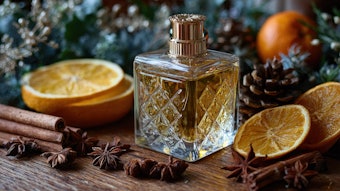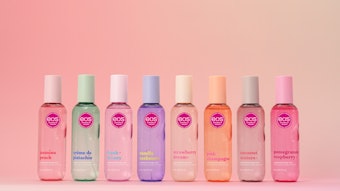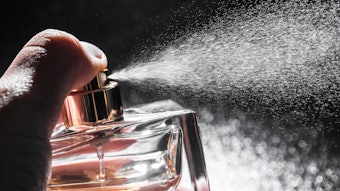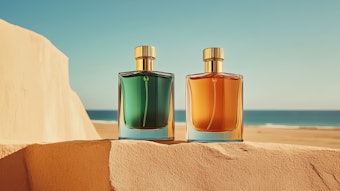The power of aroma is stunning. On its most basic level, the sense of smell is an unmatched way to protect one from the nastier things in life—an elemental “don’t put that filthy thing in your mouth” reaction. But the sense also provides a real, physical connection to the brain, and a scent can evoke compelling memories and powerful emotions. Because smells are actual, physical molecules, they produce physical responses—notably to memories.
According to Horst Rechelbacher, in his book Rejuvenation: A Wellness Guide for Women and Men, the sense of smell works in three steps—reception, transmission and perception. Reception is fairly self-explanatory, transmission is where the brain interprets the aroma and provides feedback, and perception is the reaction to the aroma. This is the step in which the brain releases chemical messages that activate hormones and regulate body functions.
The essence of plants and flowers, a molecular gas in which their fragrance lies, stimulates a reaction through sympathetic and parasympathetic nervous systems, which then causes a corresponding psychological reaction. According to Rechelbacher, different aromas produce different psychological and physiological reactions. Essences in their purest form function as natural remedies because they re-establish mental and physical balance.
Rechelbacher states that aromatherapy, the therapeutic use of essential oils, is appropriate for the treatment of physical imbalances. Aromatherapy products are created by distilling plants that are harvested in full bloom to their pure essence, and a true essential oil must be isolated by physical means—distillation. It is only in this process that plant material releases the enzyme-bound essential oil. The idea behind aromatherapy is that the purity and potency of this distilled essence are active as the molecules disperse to create a revitalizing effect.
Aromatherapy is based on the principles of ayurveda, which, although thousands of years old, has garnered growing interest at spas over the past decade. Ayurveda is described as harnessing the energies of nature to establish a harmonious relationship between the individual and the environment, and it is this relationship that promotes overall well-being.
New Applications
Fleur Aromavedic Treatment, inspired by both ayurvedic medicine and aromatherapy, are three-oil blends. According to the company, just as the body craves certain foods during physiological cycles, the aromas of essential oils an individual is attracted to are the ones that will naturally balance that individual’s emotions. The individual essences are chosen for their specific therapeutic properties, and the products are designed by scientists and tested in vitro or in volunteer studies.
Fleur’s Energizing Oil is a blend of rosemary, coriander and ylang-ylang (with lily of the valley to soften and balance the overall aroma) that is intended to revitalize. Relaxing Oil contains lavender, chamomile and petitgrain (blended with the perfume of lilies) designed to calm and soothe the senses and relieve stress, and Delight Oil offers geranium, rosewood and ginger combined with the essence of violet to promote a positive state of mind.
According to the company, the products are created by using the vacuum microwave hydro distillation technique that uses low temperature, low pressure and no solvents to preserve all of the nutrients from the flowers and plants.
New technologies and delivery methods have allowed companies to expand the range of products and benefits offered. Fleur, for example, combines floral agents with an efficiency booster selected for specific properties to optimize the action of the product. These boosters include vitamins, minerals and fruit to complement the value of the floral extract. Because essential oils also offer benefits as they are absorbed through the skin—where, upon dissemination into deeper tissues, benefits are carried throughout the body via blood and lymphatic capillaries—massage oils are a popular vehicle. Fleur’s Massage Oil is formulated with 100% apricot oil, which is naturally rich in vitamins, minerals and fatty acids.
Hot paraffin wax dips are ideal for delivering aromatherapy benefits, and Spa Revolutions recently introduced Perfectsense Paraffin & Aromatherapy—a single-use paraffin treatment that contains pure essential oils.
Bath & Body Works offers Breathe, a collection of six fragrance groupings designed to breathe life into skin and senses. This collection, too, is designed beyond fragrance, offering skin benefits infused with vitamins. The collection includes a body scrub, a high-lather moisture wash, foaming bath, multivitamin hand cream and a body cream that contains Niacyl™, a patented complex to rebuild the skin’s moisture barrier and stimulate cell turnover.
Fruits & Passion launched its new Aromachology collection. Another science-based aromatherapy line, the collection consists of moisturizing bath oils, foaming bath, massage oils and an essential oil roll-on. Again considering the skin to be as important a vehicle as the nose, the 10 plant extracts used in the oils are designed to both penetrate the skin through massage and enter the lungs through inhalation or vaporizing. Logically, perfumes are an excellent vehicle for aromatherapy. Viktor & Rolf’s Flowerbomb Eau de Parfum is an aromatherapeutic fragrance designed to impart a wellness benefit. A body lotion, body cream and perfumed shower gel are also available, and allow moisturizing ingredients to complement the aromatherapy.
Scientific Inspiration
Scientists, cosmetic companies and suppliers are hard at work putting aroma to the test—and the results are positive. In addition to supporting the ancient claims of aromatherapy, new benefits for both marketers and consumers have been substantiated. Research conducted by the University of Manchester, in England, showed that essential oils exhibit a powerful antibacterial action, demonstrating that the oils used in aromatherapy killed methicillin-resistant Staphylococcus aureus (MRSA) bacteria. Staph bacteria are one of the most common causes of skin infections in the United States, according to the Centers for Disease Control and Prevention (CDC). The complex mixture of chemical compounds found in essential oils was shown to kill bacteria strains and fungi after two minutes of contact.
Shiseido conducted scent research that is sure to make marketers happy. Based on research in cognitive psychology and social psychology that study how people show preferences toward repeated visual or auditory stimuli, Shiseido demonstrated that certain types of scents have a characteristic effect of heightening a preference by repeated exposures—regardless if that scent is remembered or not.
This is not Shiseido’s first endeavor to scientifically demonstrate the effects of scent. Previously, the company discovered and studied the sedative and stimulant effects of scents, their activating effects on the sympathetic nervous system, and applied findings to developing skin care, cosmetics and fragrances.
The company expects its current findings to enable it to develop fragrances that heighten one’s fragrance preference by repeated use on a daily basis and apply these discoveries in developing new products planned for launch this year.
As the understanding of natural fragrances and their effects grows, science is showing that it can maximize delivery. Dow Corning has demonstrated that enhanced fragrance delivery and odor control benefits can be obtained with silicones. Through its Experience the Difference program, the company states that formulators can create unique, aromatic formulations through the use of silicones.
Silicone as an effective fragrance delivery system is demonstrated in a clear perfume gel dispersion of a high molecular weight silicone surfactant, a powder perfume and a shower gel that contains fragrance beads that melt on the skin to deliver long-lasting fragrance. Additionally, Dow’s Soothing Citrus Aromatherapy Mask delivers essential oils to the skin.
It is interesting to note that the idea of what smells good doesn’t really seem to change as technology advances how a fragrance gets to the nose. Lavender exhibits calming, sedating and uplifting properties, and, therefore, has been used historically to treat depression and insomnia. It actually stimulates the production of serotonin, which is depleted during times of stress. According to Fleur, year by year, lavender proves to be the most popular essential oil. We find it smells good because it feels good. That’s a trend that never changes.
With contributions from Nancy Jeffries










